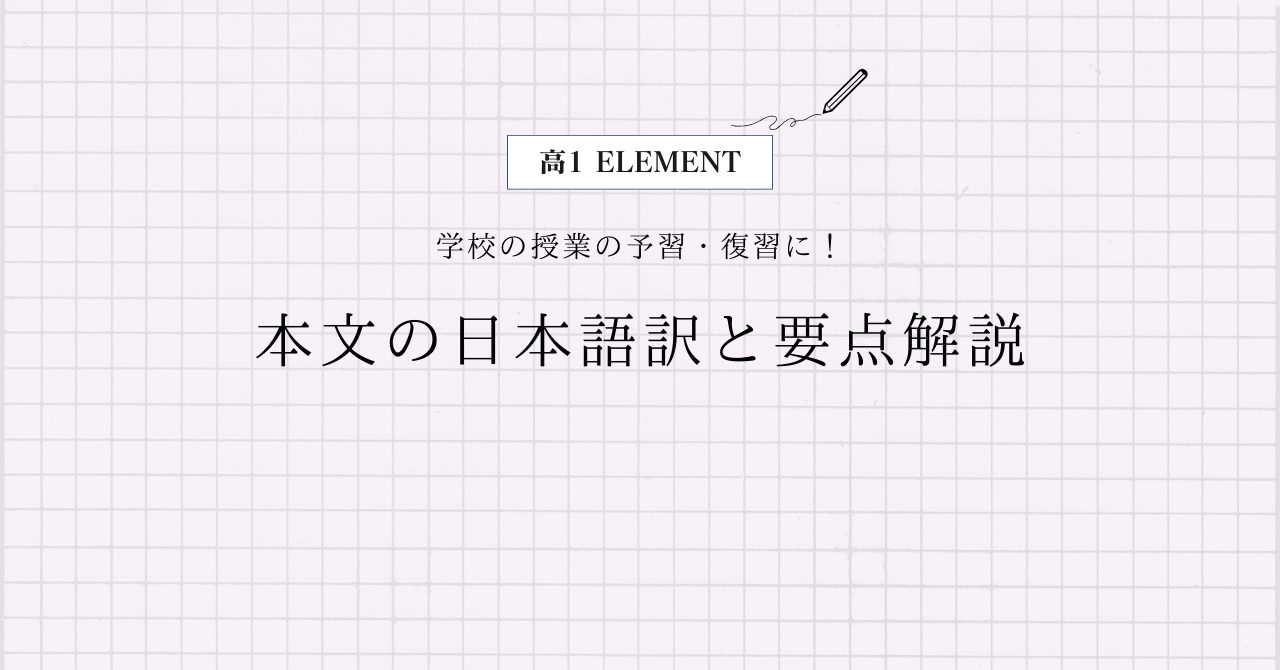三省堂 高1ELEMENT Lesson1 Section2の本文の日本語訳と重要箇所の解説です。
Lesson1-1, 1-3, 1-4の解説はこちらからご覧ください。
>高1ELEMENT Lesson1 Section1 本文和訳
>高1ELEMENT Lesson1 Section3 本文和訳
>高1ELEMENT Lesson1 Section4 本文和訳
- ELEMENT Lesson1 Section2 本文と日本語訳
- ELEMENT Lesson1 Section2 重要事項の解説
- After that she traveled to many countries and wrote about her experiences in them.
- In her travels, she visited Japan and fell in love with the cherry blossoms.
- She especially loved to see the reflection of the cherry blossoms in water.
- Planting cherry trees along the Potomac River in Washington, D.C. became her dream.
- After she returned from her first trip to Japan, she wrote letters to people in charge of national parks.
- They did not want trees from a different country, so they rejected her idea.
- She did not give up, though.
- “If you are going to plant trees, you should plant the most beautiful trees in the world.
- Those are Japan’s cherry trees with their beautiful blossoms.”
- ELEMENT Lesson1 Section2 まとめ
ELEMENT Lesson1 Section2 本文と日本語訳
After that she traveled to many countries and wrote about her experiences in them.
「その後、彼女は多くの国を旅行して、その国での経験について執筆しました。」
In her travels, she visited Japan and fell in love with the cherry blossoms.
「旅の中で、彼女は日本を訪れ、そして桜の花に心を奪われました。」
She especially loved to see the reflection of the cherry blossoms in water.
「彼女は特に、水面に桜の花が映っているのを見るのが大好きでした。」
Planting cherry trees along the Potomac River in Washington, D.C. became her dream.
「ワシントンD.C.にあるポトマック川沿いに桜の木を植えることが彼女の夢になりました。」
After she returned from her first trip to Japan, she wrote letters to people in charge of national parks.
「彼女は日本への最初の旅行から帰国した後、国立公園の責任者たちに手紙を書きました。」
They did not want trees from a different country, so they rejected her idea.
「彼らは別の国の木は欲しくなかったので、彼女のアイディアを拒否しました。」
She did not give up, though.
「しかし、彼女は諦めませんでした。」
She thought,
「彼女はこう思っていました。」
“If you are going to plant trees, you should plant the most beautiful trees in the world.
『もし木を植えるなら、世界で最も美しい木を植えるべきです。』
Those are Japan’s cherry trees with their beautiful blossoms.”
『その木というのは、美しい花を咲かせる日本の桜の木なのです。』

ELEMENT Lesson1 Section2 重要事項の解説
After that she traveled to many countries and wrote about her experiences in them.
“after”は「~の後で」という前置詞で、“that”は前回までのストーリーを指していますね。
“travel”は「旅行する」という動詞で、“write about~”は「について執筆する」という意味です。
“experience”は「経験、体験」という名詞で、“them”は“many countries”を指しています。
In her travels, she visited Japan and fell in love with the cherry blossoms.
この“travel”は「旅、旅行」という名詞です。
“fell”は“fall“の過去形で、“fall in love with~”で「~に恋に落ちる、に心を奪われる」という重要表現になります。
“cherry blossom”は「桜の花」という名詞ですね。
She especially loved to see the reflection of the cherry blossoms in water.
“especially”は「特に」という副詞です。
“to see”は「不定詞の名詞的用法」になっていますね。
“reflection“は「反射、反映」という名詞、“of”は前置詞で,”A of B”の形で「BのA」というように後ろから前に訳します。
今回は「桜の花が映る」と訳しました。
Planting cherry trees along the Potomac River in Washington, D.C. became her dream.
“plant”は「を植える」という動詞で、ここでは「動名詞」になっていますね。
“along”は「に沿って」といった前置詞で、“became”は“become(になる)”の過去形です。
After she returned from her first trip to Japan, she wrote letters to people in charge of national parks.
この“after”は後ろに文が続いているので、「~の後で」という接続詞です。
“return”は「戻る、帰国する」といった動詞で、“first”は「最初の、初めての」という形容詞、“trip”は「旅行」という名詞ですね。
“in charge of~”は「~を担当して、~の責任者である」といった重要表現で、“national park”は「国立公園」という名詞になります。
They did not want trees from a different country, so they rejected her idea.
“They”は“people in charge of national parks”を指していますね。
“different”は「異なった、別の」といった形容詞になります。
“so”は「だから」という接続詞で、“reject”は「を拒否する、断る」という動詞です。
She did not give up, though.
“give up”は「諦める」という重要表現ですね。
“though”は「しかし、~だけれど」といった副詞です。副詞の場合は、今回のように文末にカンマとセットで使います。
“If you are going to plant trees, you should plant the most beautiful trees in the world.
この文では「接続詞if」が使われています。また、「未来形」を作る“be going to”もありますね。
“should”は「~すべきだ、~のはずだ」という助動詞で、“beautiful”は「最上級」になっています。
Those are Japan’s cherry trees with their beautiful blossoms.”
“those”は“that”の複数形で,「あれらは(の)」といった意味になりますが,「それらは(の)」と訳すことが多いです。ここでは“the most beautiful trees in the world”を指していますね。
名詞に‘sを付けると「~の」という所有を表します。
直前の名詞が複数形のときは” teachers‘ “のようにアポストロフィーだけを最後に付けます。
“with”は前置詞で「~と一緒に」と訳すことが多いですが,必ずしも後ろに人が来るわけではありません。イメージとして「~とセットで」と覚えておきましょう。
“blossom”が「花」という名詞なので、今回は「花を咲かせる」としました。
ELEMENT Lesson1 Section2 まとめ
以上がELEMENT Lesson1 Section2の日本語訳となります。
「不定詞」「動名詞」の使い方をしっかり確認しておきましょう!
>高1ELEMENT Lesson1 Section1 本文和訳
>高1ELEMENT Lesson1 Section3 本文和訳
>高1ELEMENT Lesson1 Section4 本文和訳
何か分からない点や他に解説してほしい点があれば,お気軽にコメントしてください!


コメント